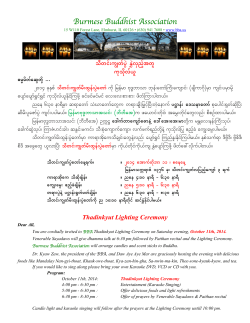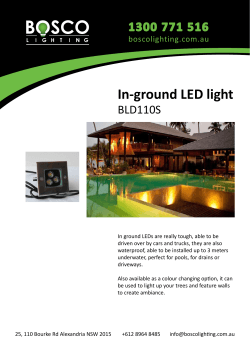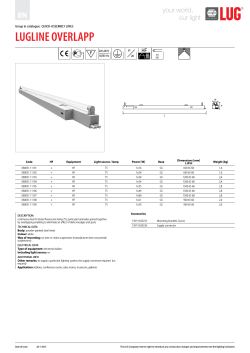
What should I know before selecting LED lighting for my aircraft?
What should I know before selecting LED lighting for my aircraft? When LED lighting is suggested, the irresistible inference is that your cabin interior will look great and that the system will be exceptionally reliable. LED lighting can deliver these benefits and much more, but your choice of system is important because some manufacturers are building more into their designs than others. In this paper we outline what you should know about LED lighting before selecting a system for your aircraft. The benefits of LED cabin lighting Well-designed LED cabin lighting products can be installed rapidly and with no changes to aircraft wiring and procedures. Detailed below are the benefits which can be delivered by the very best LED lighting systems. Passenger experience benefits: these include bright illumination which is consistent throughout the cabin and a choice of colour accents which can be matched to brand livery. Full mood lighting systems also enable the use of different colour accents during the flight which may be helpful in influencing passenger behaviour. Maintenance benefits: a well-designed LED cabin lighting system can deliver exceptional reliability and significant reductions to maintenance costs. Environmental benefits: these include reductions to weight and electrical load compared to OEM equipment, both of which result in fuel savings, and replaceable lighting units containing no hazardous waste e.g. mercury. © Cobalt Aerospace Ltd. 2015 It is also worth noting that reduced maintenance costs and fuel savings provide direct financial benefits and enhanced passenger experience may also have a positive impact on profitability. So there are clear advantages to replacing fluorescent tubes with a good LED lighting system. However, upgrading to LED lighting can be considerable investment and some manufacturers are building more into their designs than others. In this paper, we outline what you should know about LED cabin lighting before you select a system for your aircraft, by answering the following questions: Is an MTBF of 100,000 hours as good as it sounds? Should the system I choose include built in age correction? Is LED binning enough to ensure brightness and colour consistency throughout the cabin? Is blue light the right choice? Page: 2 MTFB deals with the period of product life during which it exhibits a constant failure rate, meaning it hasn’t ‘worn out’ and failures are random events that occur at a constant rate in time, for example: ‘0.01 light units fail per hour’ or to put it another way, if we had 100 light units we would expect to see 1 fail per hour. MTBF is the inverse of failure rate - the failure rate in the example above is 0.01 per hour, giving an MTBF of 1/0.01=100 hours. 25 year old humans have a failure rate of about 0.12% per year which gives the published MTBF (strictly Mean Time To Failure, MTTF) of about 839 years. They do however wear out after about 70-80 years rendering the MTBF pretty useless in determining how often you need to replace human beings. Cobalt Aerospace LED Lighting System Installed on an Airbus A319 Is an MTBF of 100,000 hours as good as it sounds? Mean Time Between Failures (MTBF) is probably the most misunderstood and deliberately misused term in product marketing. What does this mean in terms of choosing an LED lighting product to replace your aircraft fluorescent tube system? Although the typically quoted MTBF of 100,000 hours sounds impressive, there will be in the region on 100 units fitted to a typical aircraft which gives a system wide MTBF of 1,000 hours. This means it should be expected that one unit in the system will fail every 1,000 hours and, given typical usage, that is equivalent one or two units failing per year. This is good but not very different from a fluorescent lighting system. Statistically it is true the MTBF of a 25 year old human is about 830 years. Statistically it is true that only 33% of units will reach their MTBF time (and not because the stated MTBF is incorrect). However, LED lighting units actually are more reliable than fluorescent tubes but the important measure of reliability to consider is the wear out point. MTBFs are much quoted by those selling LED lighting systems but these two statistics clearly show that we need to think a little harder about what MTBF figures mean before we accept them at face value. A fluorescent tube will be considered to have worn out due to complete failure, colour shift or dimming long before an LED lighting unit incorporating age-correction measures shows any sign of age. © Cobalt Aerospace Ltd. 2015 Page: 3 Should the system I choose include built in agecorrection? An LED emits light over a very narrow spectrum making it virtually monochromatic red, green or blue. White light consists of wavelengths from the entire visible spectrum. To provide apparent white light using LEDs there are two possibilities: 1. Use red, green and blue LEDs and mix the light they emit together; or 2. Coat a blue LED with phosphor which absorbs the blue light and reemits it across a range of wavelengths to provide an approximation to white light – this is commonly referred to as a ‘white LED’. Age correction can be achieved in one of two ways: 1. Measure the light output with a sensor and provide feedback to the control system to correct for the changes; or 2. Collect data for the changes over time and correct the drive current accordingly. Both methods work but the second is more reliable because the sensors used in method 1 can themselves age and thereby provide inaccurate measurements. So, to maintain homogeneous light throughout the cabin beyond the first year or so of service, you should look for a system with age correction built in to the design and a ‘data collection’ based correction is more reliable than a ‘sensor based’ correction. LEDs are sold according to the colour and the brightness for a given drive current. Over time and influenced by temperature, the colour changes and the intensity decreases. Red LEDs degrade more drastically than blue and green and with white LEDs, the phosphor coating begins to allow more blue light through. What you are likely to notice, therefore, is lower light levels and a shift towards blue. Currently, very few LED lighting systems address the effects of LED ageing. When a unit fails (e.g. one of the units with MTBF of 100,000 hours failing after the system has been in service for a year), the replacement unit will be brighter and subtly different in colour from the original, and therefore aged, units. Since one of the attractions of LED lighting systems is the homogeneity of the lighting throughout the cabin, selecting a system without age correction, may soon result in disappointment with the overall lighting effect. © Cobalt Aerospace Ltd. 2015 Page: 4 Is ‘LED binning’ enough to ensure brightness and colour consistency throughout the cabin? Whilst fluorescent tubes can be routinely manufactured with negligible differences in brightness and colour, LEDs leave production exhibiting a wide variation in both these important characteristics. LED manufacturers test each LED and separate them into ‘bins’ closely matched for brightness and colour. This process is referred to as ‘LED binning’. So, LED binning is not enough to ensure brightness and colour consistency throughout the cabin. The solution is to manufacture lighting units using red, green, blue and white LEDs and perform calibration to a specific colour point during production by mixing those colours. This colour point can then be produced repeatedly, ensuring consistency in brightness and colour throughout the life of the lighting system. LED manufacturers then package the LEDs onto reels of 1,000-5,000 LEDs from a single bin. In LED cabin lighting systems relying solely on LED binning to achieve brightness and colour consistency, the whole shipset is manufactured using LEDs from a single reel. Reliance on LED binning has the following limitations: Given the number of LEDs on a reel, the size of aircraft for which the lighting system would be suitable is limited to the equivalent of an A319. If the LED binning has not been done well by the LED manufacturer, the brightness and colour will be inconsistent within the shipset and unfortunately these differences are easily detected by the human eye. Even if the LED binning has been done well and the shipset looks good at installation, once a unit fails and is replaced, the replacement will not have been manufactured from the same reel as the original units and the differences in brightness and colour will be obvious. © Cobalt Aerospace Ltd. 2015 An example of very bad binning used to create a line of ‘white’ LED lighting Page: 5 Most food is coloured in the green and red regions of the spectrum and few foods are naturally blue in colour. A light source with a high proportion of blue light will interact with the natural colour of most foods to make them look dark and less appetising. So, passengers are likely to find inflight food more appealing when viewed in light at the warmer end of the spectrum. Melatonin is a hormone found in animals, plants, and microbes. In animals, circulating levels of melatonin vary in a daily cycle which influences the circadian rhythms of several biological functions including sleep timing. Some ‘jet lag’ remedies contain synthetic melatonin. Natural production of melatonin is inhibited by light reaching the retina. It is principally blue light which suppresses melatonin production and the effect of exposure to blue light is proportional to the light intensity and length of exposure. Cobalt lighting units installed in the photograph above use primary (white) and secondary (red, green and blue) LED’s to allow for accurate colour calibration as well as full mood lighting effects and use age correction to maintain this over the life of the product. Is blue light the right choice? The majority of retrofit LED lighting systems are currently focussed on bringing blue light into the cabin. Some customers are requesting colours other than blue to match their brand liveries and are being told that ‘blue is best’. LED light, even when it doesn’t look blue, contains a fair portion of the blue spectrum. This is the ‘blue light hazard’ referred to today to describe the increasing amount of blue light we are being exposed to by LED lighting, computer monitors, tablet computers, smart phones etc. and the effect this is having on people’s sleep patterns. So, there is increasing awareness that high levels of blue light are likely to make passengers feel wide awake. If your passengers would benefit from sleeping whilst on board, for example during long-haul overnight flights, you should consider an LED lighting system which enables a reduction in the proportion of blue light to which passengers are exposed. In fact, blue light may not be the right choice because it can have a detrimental effect on the appearance of in-flight food and on the circadian rhythms of passengers. © Cobalt Aerospace Ltd. 2015 Page: 6 Summary Well-designed LED cabin lighting products can be installed easily and with no changes to aircraft wiring and procedures. The very best LED lighting systems can also deliver benefits in terms of passenger experience, exceptional reliability, reduced maintenance costs and fuel savings. However, some manufacturers are building more into their designs than others and, to ensure that you invest in the right LED cabin lighting system, you should consider our answers to the following questions: Is an MTBF of 100,000 hours as good as it sounds? This is realistic for a well-designed product but, given the large number of units in a shipset, you should still expect one or two failures per year. Be sceptical if you are quoted MTBF in the region of 200,000 hours, it may be that telecoms reliability standards have been used in the calculation; this is not appropriate and should not form the basis of your system comparison. Remember also that MTBF does not provide information about the expected life of the product – ask about the wear out point. Also, the rate at which an LED ages, is influenced greatly by temperature and drive current. Ask what steps have been taken to manage the heat output of the LEDs and how close to the LED current rating the LEDs are being driven. It is not recommended to exceed 50% of the rated current for the device and having more LEDs driven at a lower current will prevent thermal hotspots. © Cobalt Aerospace Ltd. 2015 Should the system I choose include built in age correction? Yes, you definitely need built in age correction. Without feedback and correction, brightness and colour consistency will be lost when failed units are replaced. Ideally, look for a system which incorporates data collection for the changes over time and corrects the drive current accordingly. Is LED binning enough to ensure brightness and colour consistency throughout the cabin? No, LED binning cannot provide brightness and colour consistency throughout the life of the lighting system. You need lighting units using red, green, blue and white LEDs and for the manufacturer to have performed calibration to a specific colour point during production by mixing those colours. Calibration derived consistency, in conjunction with built in age correction, enables the maintenance of brightness and colour consistency even after the replacement of a failed unit. Is blue light the right choice? Not necessarily. Passengers are likely to find in-flight food more appealing when viewed in light at the warmer end of the spectrum. Furthermore, if your passengers would benefit from sleeping whilst on board, you should consider an LED lighting system which enables a reduction in the proportion of blue light to which passengers are exposed. Ask which colours are available and whether the units are supplied with multiple colour options built in which would enable you to make a change later. Consider a full mood lighting system if you are interested in influencing passenger behaviour. Page: 7 About Cobalt Aerospace Cobalt Aerospace is a supplier of design and production services and is an Original Equipment Manufacturer (OEM). We provide products and services to airlines, design organisations, OEMs, integrators and VIP aircraft completion centres throughout the world, as well as designing, certifying and manufacturing our own product range for retrofit to commercial and military aircraft under a variety of STC and minor change certifications. Cobalt Aerospace has well designed LED lighting systems certified and available for retrofit to the following aircraft: Airbus A320 family Airbus A330 family Airbus A340 family Our systems are compatible with both classic and enhanced CIDS and available from white only to full mood ‘drop-in’ solutions. For further information: www.cobaltaerospace.com web@cobaltaerospace.com +44 (0)1603 327757 © Cobalt Aerospace Ltd. 2015 Page: 8 © Cobalt Aerospace Ltd. 2015 Page: 9
© Copyright 2025









